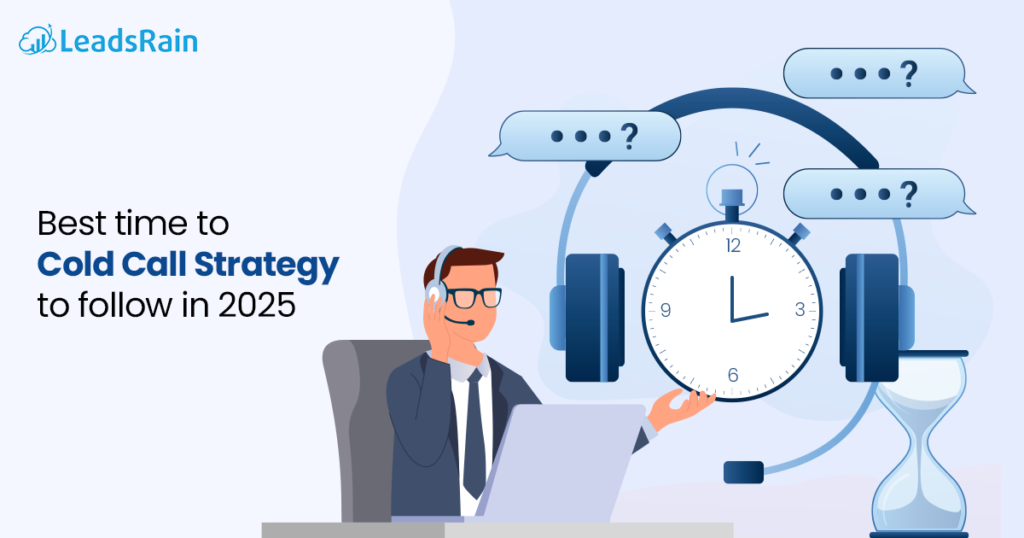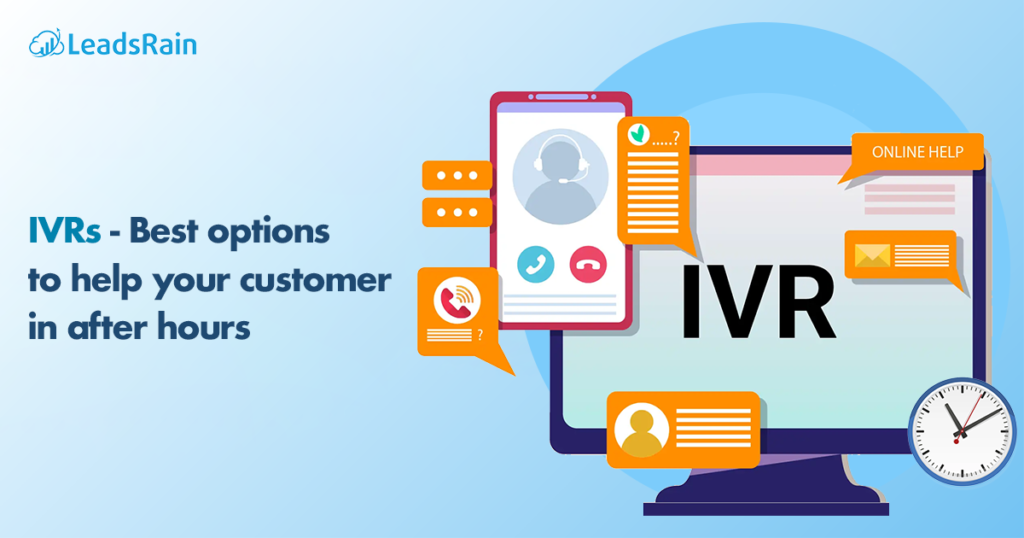The customer service sector now depends heavily on call centers. Agents handle customer questions, grievances, and support concerns in a single location over the phone, email, chat, or social media. It has become even more critical for contact centers to provide top-notch customer service with the growth of digital communication channels. Contact center quality assurance (QA) ensures that agents give consumers the best experience possible.
In this article, We will talk about the value of call center quality assurance, its procedures, and how it affects customer satisfaction
What is Call Centre Quality Assurance?
Call Centre Quality Assurance is the practice of keeping track of and rating the effectiveness of customer interactions with agents in a call center or customer service operation. Customer satisfaction and high-quality customer service are the main objectives of call center quality assurance (QA).
Monitoring calls, chats, or other customer interactions between agents and customers is a regular part of the call center quality assurance process. Agent performance is measured using metrics and key performance indicators (KPIs), and coaching and feedback are given to agents to help them perform better and hit their goals.
In order to enhance processes and make adjustments to stop the recurrence of problems, root cause analysis is also used to determine the underlying causes of customer complaints and concerns.
What Does Call Centre Quality Assurance Include?
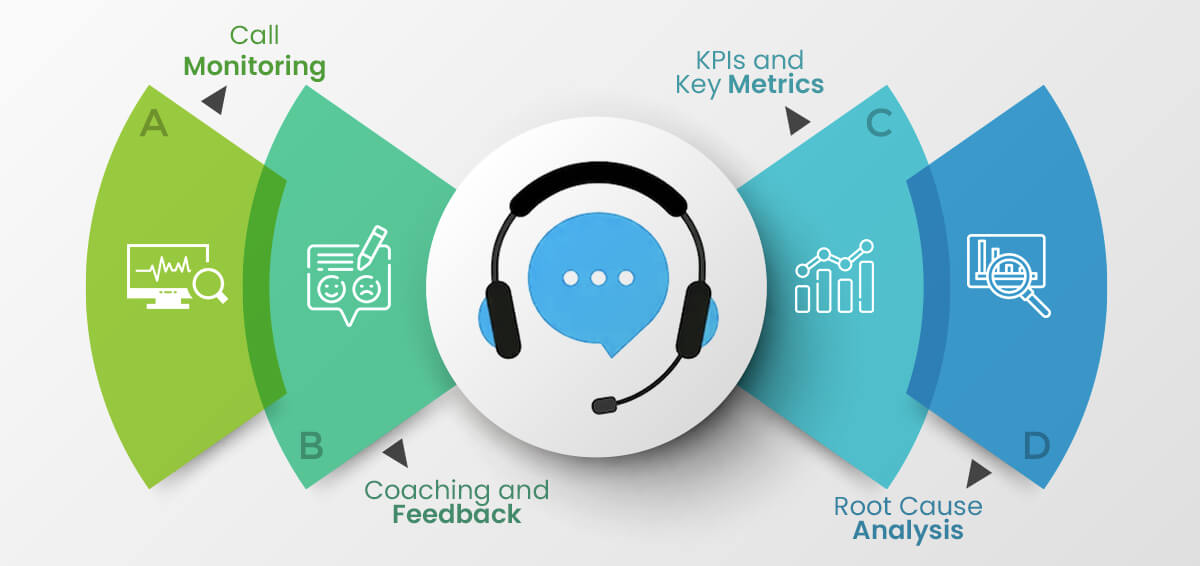
1. Call Monitoring:
Call monitoring entails listening in on customer and agent conversations. It is a crucial step in the QA process since it reveals areas where agents’ performance has to be enhanced. Real-time monitoring and retrospective monitoring are both options. Supervisors have the ability to listen in on calls in real-time and give agents feedback right away. Recorded calls can be listened to afterward to spot areas where agents need more coaching or training.
2. KPIs and Key Metrics
Agent performance is measured by metrics and KPIs (Key Performance Indicators). The number of calls answered, the typical handling time, the first call resolution rate, and customer satisfaction ratings are a few examples of these measures. Agents can use KPIs to gauge their performance and determine where to concentrate their efforts.
3. Coaching and Feedback:
The Call Center QA process must include coaching and feedback. Agents may enhance their performance and achieve goals with regular coaching and feedback sessions. One-on-one coaching sessions, group coaching meetings, and feedback reports are just a few of the ways feedback can be given. It’s critical to give constructive criticism-free feedback that emphasizes opportunities for development rather than faults.
4. Root Cause Analysis:
Finding the underlying reasons for customer complaints and issues is done through the technique of root cause analysis. Finding the problem’s underlying source requires going behind the visible symptoms. In order to make process improvements or changes that will stop recurrent problems from happening, root cause analysis is helpful.
Why is Call Centre Quality Assurance Important?
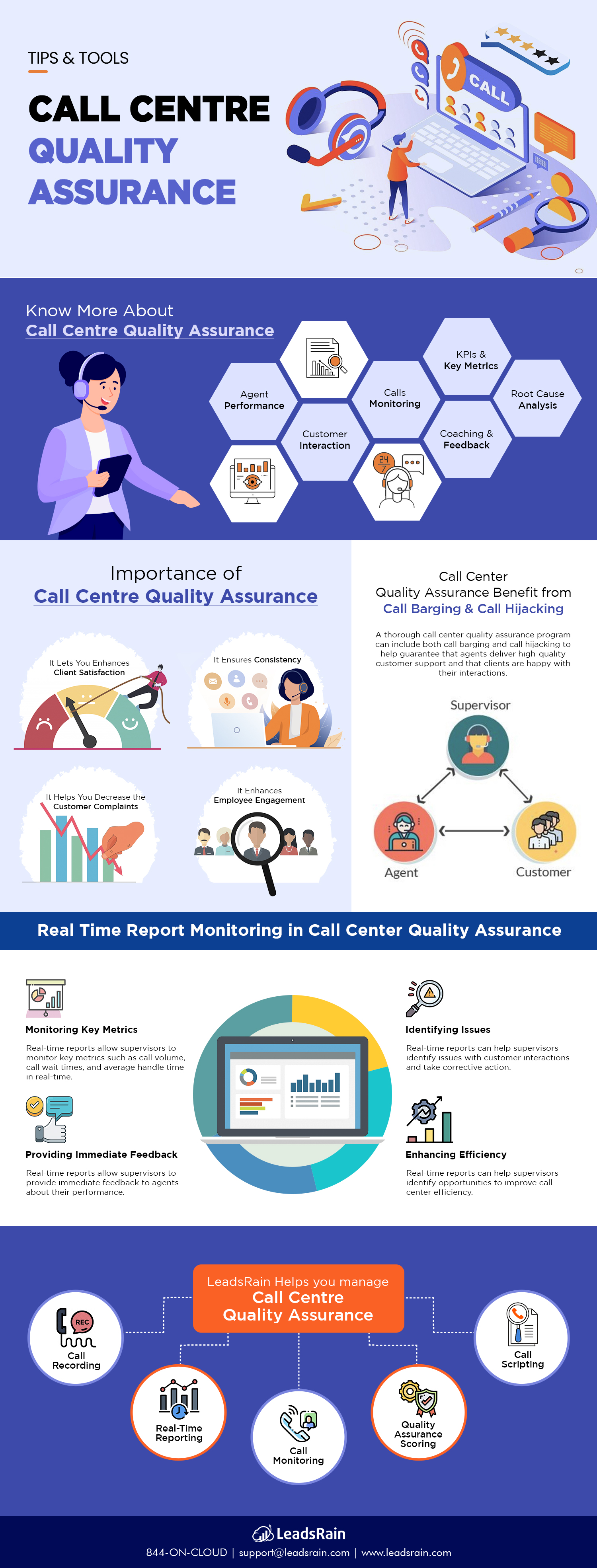
It Lets You Enhances Client Satisfaction:
Assuring that agents offer excellent customer service is the main objective of call center quality assurance. Customers are more likely to be happy with the service they receive when agents are well-trained, competent, and capable of handling consumer inquiries and complaints effectively. Increased customer loyalty and better customer retention can result from a satisfying customer experience.
It Ensures Consistency:
A consistent level of service is delivered by agents thanks in part to call center quality assurance. Building confidence with consumers and ensuring they get the same caliber of service each time they deal with the business depends on consistency. Also, consistency promotes customer loyalty and a solid brand reputation.
It Helps You Identify Improvement Needs:
Contact center quality assurance assists in locating areas where agents’ performance has to be enhanced. This can cover topics like effective communication, product expertise, or dealing with challenging clients. By identifying these areas for development, it is possible to provide customized coaching and training to agents, which enhances both their performance and the client experience.
It Helps You Decrease the Customer Complaints:
Contact Center QA may assist in lowering the number of customer complaints by identifying areas for improvement and offering specialized training and coaching. This not only enhances the client experience but also lessens the effort for the agents and lowers the volume of support team escalations.
It Enhances Employee Engagement:
Contact center quality assurance can enhance work satisfaction and employee engagement. When agents receive regular coaching and feedback, they feel encouraged and valued in their positions. More job satisfaction and increased staff retention rates may result from this.
How Can Call Center Quality Assurance Benefit from Call Barging and Call Hijacking?
Two elements that may be utilized in a call center to boost call center quality assurance (QA) and make sure that employees are delivering excellent customer service are call barging and call hijacking.
“Call Barging” enables a manager to join a call between an agent and a customer. This can be utilized to give the agent rapid feedback or to assist in solving a challenging problem that the agent may be facing. By participating in the call, the manager can support and mentor the agent while also assisting in the prompt and efficient resolution of the customer’s issue. In order to monitor calls and make sure that agents are adhering to business standards and procedures, call barging can also be employed.
“Call Hijacking” is a feature that enables a manager to take control of a call between a customer and an agent. This can be applied when a customer or agent has trouble resolving a problem. By picking up the phone, the supervisor may offer instant support and ensure the client’s problem is remedied quickly and satisfactorily. A crisis can be de-escalated and a customer’s anger or annoyance avoided by using call hijacking.
A thorough call center quality assurance program can include both call barging and call hijacking to help guarantee that agents deliver high-quality customer support and that clients are happy with their interactions. Supervisors may assist agents in performing better and satisfying customers by giving them quick feedback and support. This improves business results and creates a better customer experience.
What Role Real Time Report plays in Call Centre Quality Assurance?
Real-time reports are critical in Call Centre Quality Assurance (QA) by providing supervisors with up-to-date information about agent performance and customer interactions. Here are some of the critical ways that real-time reports can enhance Call Centre QA:
Monitoring Key Metrics:
Real-time reports allow supervisors to monitor key metrics such as call volume, call wait times, and average handle time in real-time. By keeping track of these metrics, supervisors can quickly identify issues and take corrective action to ensure that customers receive high-quality service.
Identifying Issues:
Real-time reports can help supervisors identify issues with customer interactions and take corrective action. For example, if a supervisor notices a high volume of calls waiting in the queue, they can quickly allocate additional resources to handle the call volume and reduce customer wait times. By taking corrective action quickly, supervisors can help to ensure that customers receive prompt and effective service.
Providing Immediate Feedback:
Real-time reports allow supervisors to provide immediate feedback to agents about their performance. By monitoring key metrics such as call duration, call transfer rates, and customer satisfaction scores, supervisors can quickly identify issues and provide coaching and guidance to help agents improve their performance.
Enhancing Efficiency:
Real-time reports can help supervisors identify opportunities to improve call center efficiency. By tracking metrics such as average handle time and call transfer rates, supervisors can identify areas where agents may be spending too much time on calls or transferring calls unnecessarily. This information can be used to identify process improvements and training opportunities that can help agents work more efficiently.
How LeadsRain Helps you manage Call Centre Quality Assurance?
LeadsRain is a cloud-based call center solution that offers a range of features to help you manage Call Centre Quality Assurance (QA) and ensure that your agents are providing high-quality customer service.
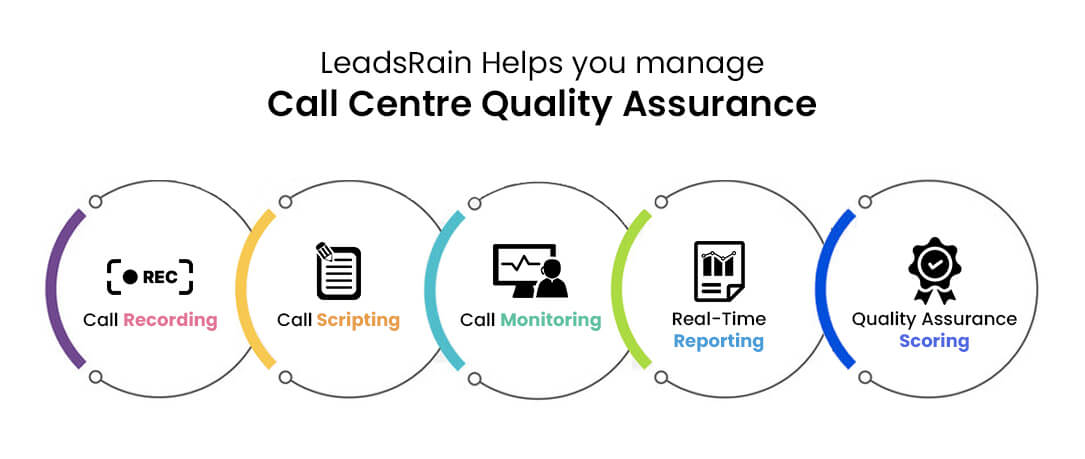
Here are some of the ways that LeadsRain can help you manage Call Centre QA:
1. Call Recording:
LeadsRain offers call recording as a standard feature, allowing you to record all customer interactions for quality control purposes. Call recordings can be used to evaluate agent performance, identify areas for improvement, and ensure that agents follow company policies and procedures.
2. Real-Time Reporting:
LeadsRain offers real-time reporting, allowing you to monitor key metrics such as call volume, wait times, and average handle time in real-time. This information can be used to identify issues and take corrective action quickly, ensuring that customers are receiving prompt and effective service.
3. Call Monitoring:
LeadsRain allows supervisors to listen, barge and hijack live calls or to join calls in progress to provide immediate feedback to agents. This can be used to provide coaching and guidance to help agents improve their performance or to help resolve complex issues that the agent may be struggling with.
4. Quality Assurance Scoring:
LeadsRain allows supervisors to score agent performance based on predefined criteria, such as adherence to call scripts, politeness, and accuracy. This information can be used to identify areas for improvement and to ensure that agents are providing high-quality customer service.
5. Call Scripting:
LeadsRain allows you to create call scripts that agents can use to ensure consistency in customer interactions. By providing agents with scripted responses to common customer questions or issues, you can ensure that customers receive a consistent level of service regardless of which agent they speak with.
LeadsRain offers a range of features to help you manage Call Centre QA and ensure that your agents provide high-quality customer service. By providing tools for call recording, real-time reporting, call monitoring, quality assurance scoring, and call scripting, LeadsRain can help you to identify areas for improvement, provide coaching and guidance to agents, and ensure that customers receive a consistent level of service.
Want to know more? Connect with us at support@leadsrain.com or schedule a call with our expert now.

